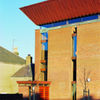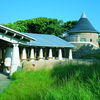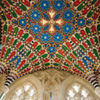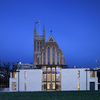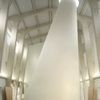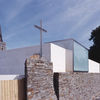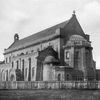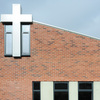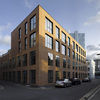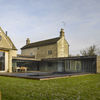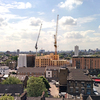Bushey Cemetery
Subscribe now to instantly view this image
Subscribe to the Architects’ Journal (AJ) for instant access to the AJ Buildings Library, an online database of nearly 2,000 exemplar buildings in photographs, plans, elevations and details.
Already a subscriber? Sign in
The site is an 8.5ha clay-soiled field, sloping south-east from the existing cemetery grounds
Jim Stephenson Download Original
Waugh Thistleton has built a series of rammed earth structures at Bushey Jewish Cemetery in Hertfordshire.
The cemetery buildings form a deliberately modest composition, and the chapels’ rammed-earth structures were chosen for their simultaneously monumental and poetic qualities.
The assembled structures are arranged to serve the Jewish burial narrative. There is a simple timber reception building and porte-cochère, set at an angle to leave an ancient oak undisturbed; a few metres away, a continuous, larch glulam colonnade runs past the front of the two rammed-earth prayer halls, each with a smaller accompanying volume for Cohanim priests in the same material.
A timber-built mortuary is at the north end and stands slightly separated from the chapels. The traditional Jewish separation of spiritual and secular territory is also evident in the gaps between the colonnade and the chapels, and between the chapels and the rooms for the Cohanim, who do not enter the chapels or come close to the coffins or graves.
Waugh Thistleton had no previous knowledge of rammed-earth construction, and its client, United Synagogues, had to be convinced that the material was feasible. The engineer, Elliott Wood, identified an experienced stabilised rammed-earth specialist in Australia with a British-based associate, Bill Swaney.
Swaney built a demonstrably durable sample wall section using 500mm-thick rammed-earth blocks composed of sand, limestone, gravel, 5 per cent cement, and clay spoil from the swales-cum-ponds created at the two lowest and wettest edges of the site.
The physicality of the rammed-earth façades, which sit on a stepped concrete upstand, is engrossing. The faces of the individual blocks have subtly uneven surfaces and colourations, marked with filled-in formwork tie-holes and wavering chamfered vertical joints.
The halls, entered from the west through large Cor-ten doors, are lined with a timber-slatted cowl which stops about two-thirds of the way into the space and gives way to rammed-earth walls lit from full-width west-facing glazing in the stepped ceiling.
The trapezoidal plan of the green-roofed chapels produces two right-angled corners and one façade that is slightly angled in plan, and these façades face each other across the open-air prayer space. Atmospherically and spatially, the chapel interiors and the outdoor gathering place give the mourning and burial ceremony a memorable narrative.
Data
- Begun: Aug 2015
- Completed: Jul 2016
- Floor area: 494m2
- Sector: Religious
- Total cost: £6.1M
- Procurement: JCT standard building contract with quantities
- Address: Little Bushey Lane, Bushey, WD23 3TP, United Kingdom
Professional Team 
- Architect: Waugh Thistleton Architects
- Project architect: Rachel Crozier
- Client: United Synagogues
- Structural engineer: Elliot Wood
- M&E consultant: P3R Engineers
- QS: Deacon & Jones
- Landscape consultant: J & L Gibbons
- Project manager: Deacon & Jones
- CDM co-ordinator : Vance Miller
- Approved building inspector : Assent
- Main contractor: Buxton
- CAD software used: Vectorworks
Suppliers
- Structural rammed earth: Earth Structures
- Aluminium windows: Reynaers Windows,
- Floor Tile Supplier: Solus Ceramics
- Cor-ten steel doors, arch and canopies: Suffolk & Essex Joinery





















